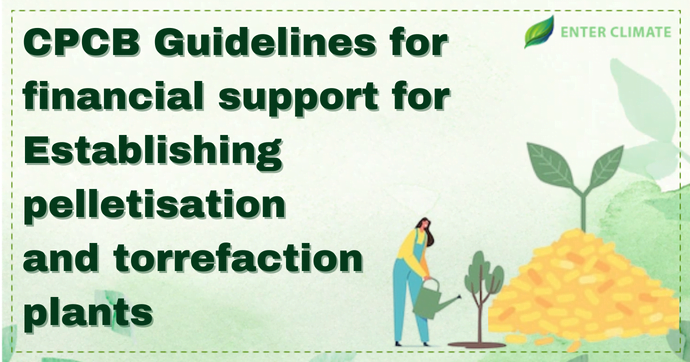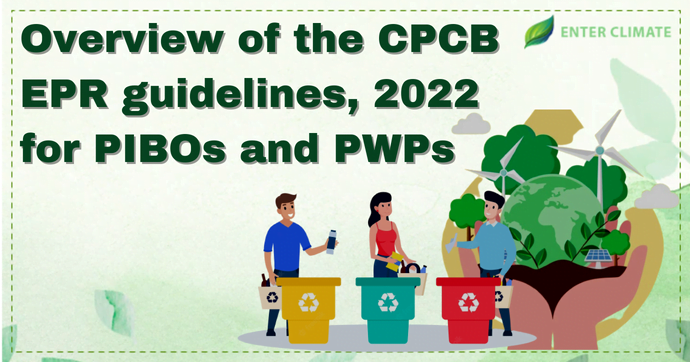CPCB Guidelines for financial support for Establishing pelletisation and torrefaction plants
 05 Jan, 2023
05 Jan, 2023 
Burning of paddy straw has been one of the main reasons for degrading air quality in northern states of the country, especially in Delhi. The degrading AQI in Delhi during winter has been a significant concern for many years now. The Central Government rigorously dealt with the issue due to stubble burning in NCR in the past. In October 2022, as a proactive measure, the Central Pollution Control Board released a detailed guideline on its financial assistance program under the Environment Protection Charge(EPC) for establishment of pelletisation and torrefaction plant in the NCR region. By this, the government aims to direct the waste paddy straw into alternative fuel for industries, thermal power plants etc. Secondly, this will reduce the usage of fossil fuels in industries and boilers by promoting the usage of pelletised/torrefied paddy straws. Additional measures are also being taken to augment the demand side too. Steps have been taken to encourage the use of these pellets in energy-intensive industries. Therefore the government has issued directions to 11 power plants within a radius of 300 km of Delhi for initiating immediate steps to co-fire biomass-based Pellets, torrefied pellets/briquettes with coal. Further, directions have been issued to units operating in NCR region other than NCT of Delhi to switch to PNG or biomass fuels. The following are the conditions applicable to this scheme.
- Applications for the establishment of pelletisation and torrefaction plants will be considered on a first-come-first-serve basis.
- The applicant must bear the cost of land, including other civil works.
- The applicant must submit a bank guarantee, equivalent to the amount released, in the name of SPCB, with a validity of at least one year which will be released back to the applicant after the start of commercial production, i.e. submission of the first invoice for the sale of the product.
- The application for the establishment of pelletisation and torrefaction plant must have the recommendations of the concerned State Pollution Control Board.
- Preference will be given to those units which have an agreement with farmers located in the NCT of Delhi, and NCR districts of Rajasthan, Uttar Pradesh and the States of Punjab & Haryana, to ensure an regular supply of paddy straw.
- In the case of pelletisation plants, a maximum aid of Rs. 14 lakhs per ton production capacity per hour will be given as one-time financial aid by CPCB up toRs. 70 lakhs per proposal.
- In the case of torrefaction plants, a maximum amount of Rs. 28 lakhs per ton production capacity per hour will be given as one-time financial aid by CPCB, up to Rs. 1.4 crore per proposal.
- All mandatory approvals and clearances needed for the establishment of the pelletisation and torrefaction plant will be the responsibility of the applicant.
Basic Requirement of the Establishment of Pelletisation and Torrefaction plant
New units that will be set up by individuals, entrepreneurs and companies after the issuance of these guidelines are eligible for this assistance, provided that they use paddy straw from the states of Punjab & Haryana, NCT of Delhi, and in the NCR districts of Uttar Pradesh and Rajasthan and supply the pellets/torrefied pellets to thermal power plants and other industries.
Pelletisation Unit: Pellet manufacturing generally consists of shredding, drying, grinding, and pellet making. In the case of paddy straw pelletisation, the paddy straw is first shredded in the shredder and, subsequently, subjected to grinding, where straw size is reduced further. After that, the straw is fed into the machine. This is followed by the cooling of pellets and storage. Since the moisture content is generally reduced within two weeks after harvesting, a drier is not required for paddy straw. Air Pollution Control Devices (APCDs) are also needed during the establishment of pelletisation and torrefaction plants[1], especially at the grinding stage, where straw is being chopped into fine sizes.
Torrefaction unit: In the case of a torrefaction plant where the biomass is processed at the temperature of 250-350°C in the absence of oxygen by decomposing the components of biomass and preserving energy so that the energy density of biomass that has been torrefied is much higher. The significant difference between torrefaction and pelletisation units is the presence of a torrefaction reactor in the latter case.
Stages in the Financial Assistance program for the establishment of pelletisation and torrefaction plant
Step 1. Application with all the supporting documents must be submitted to the Member Secretary of the respective State Pollution Control Board/ Pollution Control Committee.
Step 2: Appraisal of the application by SPCB/PCC, which will then forward it to CPCB along with its recommendations. The SPCB will appraise the application and forward it to CPCB along with its recommendations within 15 days.
Step 3. Evaluation of application by a committee constituted by CPCB.
Stage 4: Approval and release of funds based on the committee’s recommendation. CPCB will release the funds to the concerned SPCB/PCC.
Stage 5: SPCB will release the financial support within 15 days of receipt of funds from CPCB directly into the earmarked account
Note: funds will be released once the SPCB has granted Consent to Establish (CTE) to the applicant. Also, once sanctioned, SPCB/PCC will monitor the progress of the establishment of pelletisation and torrefaction plant and ensure the timely completion of the unit. SPCB will also submit a completion or commissioning report to the CPCB.
Documents Required for the establishment of pelletisation and torrefaction plant.
- Registration certificate of the company
- Proof of land ownership/ lease agreement where the proposed unit is to be set up.
- Consent To Establish (CTE) from concerned SPCB/ PCC and other statutory approvals. (Application for CTE must be submitted to the concerned SPCB/PCC before applying for assistance under these guidelines).
- Undertaking by the applicant that the unit is not receiving any form of financial assistance from any other Central Government scheme for the same plant.
Note: Preference will be to units having an agreement with local farmers for the supply of paddy straw and those committed to the sale of paddy straw pellets produced.
Similar Schemes by the government for the establishment of pelletisation and torrefaction plant
CRM Scheme: For reduced burning of paddy straw in the states of Punjab and Haryana, NCT of Delhi and NCR districts of Rajasthan and Uttar Pradesh and to subsidise machinery required for the establishment of pelletisation and torrefaction plant and other similar units using paddy straws, the scheme on ‘Promotion of Agricultural Mechanization for in-situ management of crop residue in the States of Punjab, Haryana, Uttar Pradesh and NCT of Delhi’ has been implemented in 2018-19. The Operational Guidelines of the CRM Scheme were revised in August 2022 to promote the use of bio-decomposer technology, and provisions were made for conducting large-scale demonstrations of bio-decomposer on farmers’ fields by way of utilising Flexi funds under the scheme. The ex-situ Crop Residue Management is also being encouraged under this scheme which includes alternative usage of paddy straw in biomass power projects, co-firing in thermal power plants, feedstock for 2G ethanol plants, feedstock in compressed biogas plants, fuel in industrial boilers, Waste to Energy (WTE)plants, packaging materials etc.
Conclusion
There is a constant demand for stubble pellets, but they are not met by adequate supply. Considering the 10% replacement of coal with paddy straw as aimed by the CPCB in coal-based thermal power plants in Delhi NCR, the annual requirement of paddy straw will be 75.5 lakhs MT. In addition to that, under ex-situ management, efforts are being made by the government to utilise stubble for compressed bio-gas plants, using biomass as raw material, being set up under the Sustainable Alternative towards Affordable Transportation scheme. All these indicate a huge scope of such plants in the future. Therefore the establishment of a palletisation and torrefaction plant will be resource efficient considering the financial assistance provided by the CPCB, and the unit will soon be making a profit due to the growing demand for such alternatives to fossil fuels.













